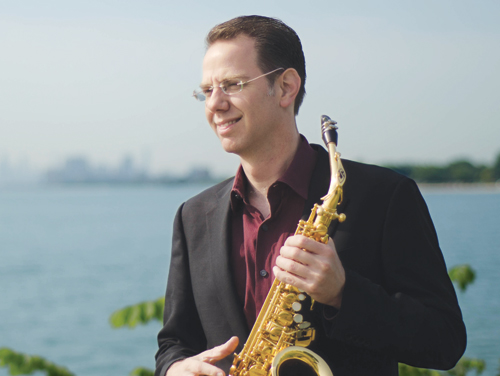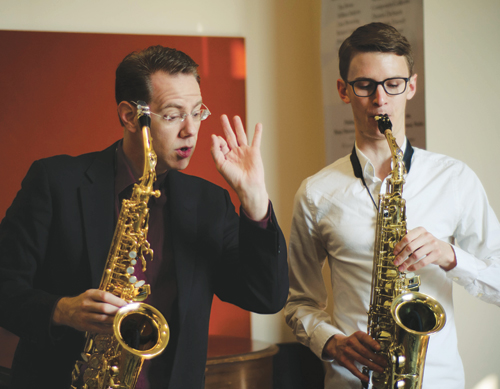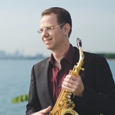
Timothy McAllister is soprano saxophonist of the PRISM Quartet and a major performing artist, appearing with ensembles and symphony orchestras worldwide, beginning with a solo debut with the Houston Civic Symphony at age 16. He is the newly appointed associate professor of saxophone at the University of Michigan and is also an adjunct professor at Northwestern University, where he was previously associate professor of saxophone and co-director of the Institute for New Music from 2012-2014. McAllister earned a Doctor of Musical Arts and other degrees in music education, conducting, and performance from the University of Michigan, where he studied saxophone with Donald Sinta and conducting with H. Robert Reynolds.
How do you recommend teaching the saxophone embouchure to beginning students?
It is important to identify the role of the chin, the amount of lower lip over the teeth, and how the corners of the mouth should be immediately. Students who develop bad habits in these areas end up spending years trying to correct them. Keep the chin down, flat and forward while keeping the lips in a phoo position. That combined with the corners in a ooh position while keeping space between the molars provides the most resonance and vibration from the reed.
What are the most important things for saxophonists to learn early in their study of the instrument?
It is crucial for a young saxophonist to understand what a correct sound is. Playing in the school band means the saxophone tone should conform to a classical style, but students frequently have the sound of pop or jazz saxophone in their minds even before they even begin study of the instrument. This can put them at a disadvantage compared to students playing other instruments, who may not have preconceived notions of how their instrument should sound. The other important thing to learn early is how to play with good intonation.
What are some of the most common problems you have encountered with beginning saxophonists?
Beginning players tend to move too quickly. They often move easily through their beginning band instruction books without addressing posture, air support, embouchure, and hand position more carefully. This can create many bad habits that must be corrected later when the demands of the music they are playing increase dramatically.
The biggest concern I have for saxophonists in modern times is that the instrument is easy to start on, but it is extremely difficult to address fundamentals at the highest level. This is untrue for trumpet or flute; if you approach those two instruments incorrectly, it will be impossible to make a decent sound on them, and for flutists and trumpet players, the early groundwork is difficult enough that they develop a strong, steady work ethic as they mature. Saxophonists have it easy for a while, but then it becomes extremely difficult to master more difficult concepts, often leading to great frustration at a later age.
How do you suggest that teachers who are not primarily saxophonists approach these difficulties?
Teachers should educate themselves on key players and recordings for all instruments, so students have something to look to for great models. The saxophone reference materials available now are better than ever. Educators can look both to the gold standard books of old, such as Larry Teal’s The Art of Saxophone Playing, and couple it with a newer method like Donald Sinta’s Voicing: An Approach to the Saxophone’s Third Register.
What tips would you offer saxophonists on producing good characteristic sounds?
The quickest tip takes patience, appreciation, and the longest amount of time to practice: long tones. Students should never take short cuts with tone development. I tell advanced high school and college players that they should spend 30-45 minutes a day on long tones and careful tuning with a high-quality tuner. Slow scale work should be done before moving to faster scale routines; this way, saxophonists can focus on even control and tone quality. After that, mouthpiece exercises can quickly improve tone. Playing scales and tunes on the mouthpiece along with using changing vowel positions and shifts in the direction of the airstream without lip pressure change can begin teaching body awareness. Students should consider what the tongue and throat are doing to produce various sounds.
What equipment do you recommend for middle and high school saxophonists?
Go with a high-end mouthpiece as soon as possible. It is the easiest and best upgrade one can make. Avoid entry-level mouthpieces that are cheap plastic blends with questionable intonation. It is probably better to upgrade to more professional level reeds as soon as possible, too, such as Rico Classic Reserve or Vandoren Traditional reeds. After that, look for a high-quality ligature such as BG, Vandoren, Bay, or Rico. The right ligature can be great for projection and control.
Is it a good idea to start beginning players on a professional-model instrument?
Until a student has a clear sense of how serious music will be for them, it is better to hold off on the great expense of pro-line horns. Student/intermediate lines are quite effective at providing a bit less resistance, and the ergonomics of such instruments fit smaller hands well. Also, the intonation and tone quality of entry-line horns are getting better all the time.
How have you seen saxophone pedagogy evolve at the middle and high school levels?
There seems to be a divide in this regard. Hungry, driven students are advancing quickly because there is an amazing array of resources available, both in print and online. In addition, these students are attending clinics and masterclasses and taking private lessons at an earlier age than students did in my generation. That said, those students who are indifferent and lacking drive are falling increasingly behind the passionate ones. Students receiving better instruction are driving the pedagogy themselves, because as they become better at an earlier age, teachers must keep up. Our jobs are to foster a faster and more developed pace for our passionate pupils than what we experienced at a similar age.

What are some of the key philosophies that govern your approach to teaching saxophone?
I want my students to be great technically, but saxophonists are able to advance quickly in this regard. Many musicians who play other instruments are skeptical of the saxophone, in part because it is a latecomer to the field of classical music, and because it is easier to learn than some other instruments. What happens is that young saxophonists often can play the instrument technically better than they are able to grow as thinking musicians and artists. This can be true in both classical and jazz music. It is my job to teach the command of tone and intonation along with deep musical concepts that every instrumentalist should apply. No one cares how fast a player can move his fingers; it is sound and musical choices that comprise a musician’s defining characteristics as an artist.
Do you think any of these philosophies are unique to you when compared to the broader scope of modern pedagogy?
The best players I know would agree with these assessments. Those of us who enforce detailed attention to fundamentals strive every day to raise the standards of saxophone playing to bring our level of playing in line with more established instruments.
Has there been any evolution in your pedagogy over the course of your teaching career?
I try not to be static as a teacher. Early on, I was quite stringent on making students conform to exactly how I wanted them to do play, think, interpret; but, now, I work to bring in multiple viewpoints. I enjoy bringing different opinions and the latest trends into students’ lessons but try not to confuse them with too many concepts from a wide array of sources. Although I maintain a common thread about what has always worked for me, I want students to understand there is more than one way to do things. The larger the framework they operate within, and the more knowledge of the field as a whole, the better.
How has having degrees in both music education and conducting influenced your saxophone pedagogy?
My training in those areas has made me a better performer and teacher. Score study and analysis only improves interpretation, and knowing intimate details of the idiomatic tendencies of other instruments through my music education methods courses has helped me better understand the parameters we must operate within as saxophonists when performing in large ensembles or chamber music.
What are some of the crucial components you look for in a prospective college-ready saxophone student?
I want to know that a college-bound student understands the demands ahead. Practicing and lessons are not extracurricular activities any longer; they are the gateway to a livelihood in music and the arts in general. These activities comprise a grade at the college level, and the relationship with one’s major professor has the greatest effect on a possible professional career. So, beyond all the repertoire and fundamentals on display, a student on audition day should show maturity, poise, and manners. Further, they must be willing to work and flourish in a competitive, but hopefully supportive, environment that a saxophone studio provides. I often will meet with prospective students prior to audition season to find out if they are open to feedback and constructive criticism. Beyond this, a college-ready student should be aware that the field of saxophone is accelerating exponentially. It is an exciting time for the instrument in all genres, and more students than ever before are interested in taking part in this profession.





